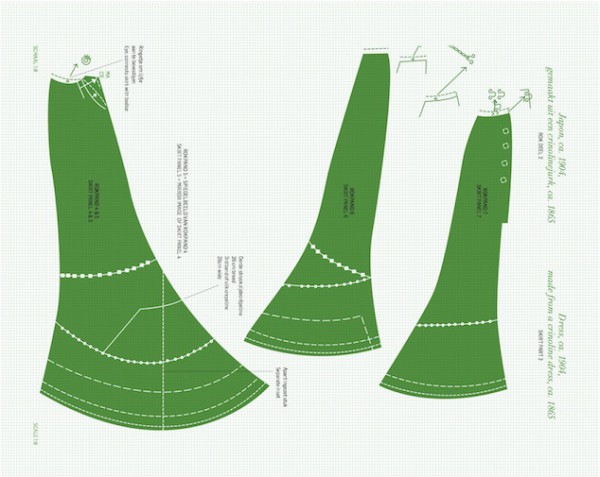Dress, ca. 1904, made from a crinoline dress, ca. 1865
When fabricating a pattern of a historical costume you will get a little bit acquainted with the wearer. Was she tall or short? Thin or fat? Did she had imperfections that needed to be camouflaged? Was she restricted in movement? Have there been alterations? You also get an insight in the techniques used for the construction.
 The basic principle for making patterns from historical costumes is quite simple. You make a cross with two threads and you place them exactly on the weave and theft of the fabric of the pattern piece you want to take the pattern of. This is your starting point. Then you start taking measurements from here on and translate them to the paper were you also have drawn a cross. This sounds easy, but it is time consuming and you will need practice and knowledge of patternmaking to get a good result. You should also be aware that forms of patterns from the 18th and 19th century differ from contemporary ones, for instance the waist levels can be quite different. But most and foremost you have to keep in mind that you are working with historical costumes and that they are very fragile! A good support of the costume is needed.
The basic principle for making patterns from historical costumes is quite simple. You make a cross with two threads and you place them exactly on the weave and theft of the fabric of the pattern piece you want to take the pattern of. This is your starting point. Then you start taking measurements from here on and translate them to the paper were you also have drawn a cross. This sounds easy, but it is time consuming and you will need practice and knowledge of patternmaking to get a good result. You should also be aware that forms of patterns from the 18th and 19th century differ from contemporary ones, for instance the waist levels can be quite different. But most and foremost you have to keep in mind that you are working with historical costumes and that they are very fragile! A good support of the costume is needed.
Karen Van Godtsenhoven, co-curator of the expo: “We included patterns of three historical costumes from the Jacoba de Jonge collection in the exhibition’s catalogue because of the rise in popularity and demand for precise historical patterns. There aren’t very many of them around. We of course expect some people might actually reproduce the costumes.â€
Text by Marieke van Es






















